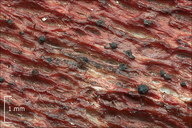|
|
click photo for larger file

Pleosporales
|
Photographer: Dr. Amadej Trnkoczy
ID: 0000 0000 0118 0162 (2018-01-03)Copyright © 2018 Dr. Amadej Trnkoczy
|
|
INFORMATION PROVIDED WITH THE PHOTO
|
date of photo Apr 5, 2017
latitude 46.35942 longitude 13.69699
View on Google Maps.
location
Lower Trenta valley; between villages Soča and Trenta, right bank of river Soča near lower hunter's trail from Na Melu place to Lemovlje, below Na skalah settlement, East Julian Alps (Posočje, Slovenia)notes Habitat: : mountain scree slope, southeast aspect; open, sunny, dry place; calcareous ground; exposed to direct rain; elevation 680 m; average temperature 6-8 deg C, average precipitations ~3.000 mm/year; alpine phytogeographical region. Substratum: dead, rotten trunk of Fagus sylvatica lying on ground. Comments: This ascomycete remains a secret for me. It appears to have perithecioid ascomata with occasionally papillate apex, cellular pseudoparaphyses, bitunicate (hope so) and clavate/cylindrical 8-spore asci, ascospores with pigmentation and several septa and peridium composed of a few layers of cells. Thus it possibly belongs to fungi order Pleosporales Luttr. ex M.E. Barr. This order comprises tens of families and thousands of species. I searched for species, which stain decaying wood reddish/purplish. I browsed through short descriptions of about 160 species studied in the paper of Zhang et al. (2009) (Table:1). Several species, which stain substratum reddish, are cited, but none fits to this observation. It is also possible that my assumption about Pleosporales is completely wrong and this find is something totally different. Hard to manage is also the fact that the traditional taxonomy based exclusively on morphology has been overturned drastically by recent molecular studies. Hense proper naming of species (even genera and families) is confusing for an amateur. Unfortunately, there was no response from AscoFrance forum either. Any help would be much appreciated. Spores smooth, septated; from 3 to 7 septa, AVG = 4.5, SD = 0.9, N = 80. Dimensions: 19,4 [24,5 ; 26,5] 31,6 x 5,2 [6 ; 6,3] 7,1 microns; Q = 3,1 [4 ; 4,4] 5,2; N = 40; C = 95%; Me = 25,5 x 6,1 microns; Qe = 4,2. Olympus CH20, NEA 100x/1.25, magnification 1.000 x, oil (asci tip, perithecia wall); NEA 40x/0.65, magnification 400x (spores, asci), in water; fresh material. Novex, Zoom Stereo RZ_Range, Holland (perithecia). AmScope MA500 digital camera. Herbarium: Mycotheca and lichen herbarium (LJU-Li) of Slovenian Forestry Institute, Večna pot 2, Ljubljana, Index Herbariorum LJF Ref.: (1) Zhang, Y. et al. “Multi-Locus Phylogeny of Pleosporales: A Taxonomic, Ecological and Evolutionary Re-Evaluation.” Studies in Mycology 64 (2009): 85–102–S5. PMC. Web. (accessed: Dec. 30. 2017). (2) http://fungi.myspecies.info/all-fungi/massariosphaeria (accessed Dec. 24. 2017) (3) https://www.asturnatura.com/especie/massariosphaeria-typhicola.html (accessed Dec. 24. 2017) (4) https://www.sites.google.com/site/funghiparadise/home (accessed Dec. 24. 2017) (5) MO Observation 84963camera Nikon D700 / Nikkor Micro 105mm/f2.8
contributor's ID # Bot_1046/2017_DSC7333 photo category: Fungi - fungi
|
MORE INFORMATION ABOUT THIS FUNGUS
|
| View all photos in CalPhotos of Pleosporales Check Google Images for Pleosporales |
|
The photographer's identification Pleosporales has not been reviewed. Click here to review or comment on the identification. |
|
Using this photo The thumbnail photo (128x192 pixels) on this page may be freely used for personal or academic purposes without prior permission under the Fair Use provisions of US copyright law as long as the photo is clearly credited with © 2018 Dr. Amadej Trnkoczy.
For other uses, or if you have questions, contact Dr. Amadej Trnkoczy amadej.trnkoczy[AT]siol.net. (Replace the [AT] with the @ symbol before sending an email.) |
|
|
